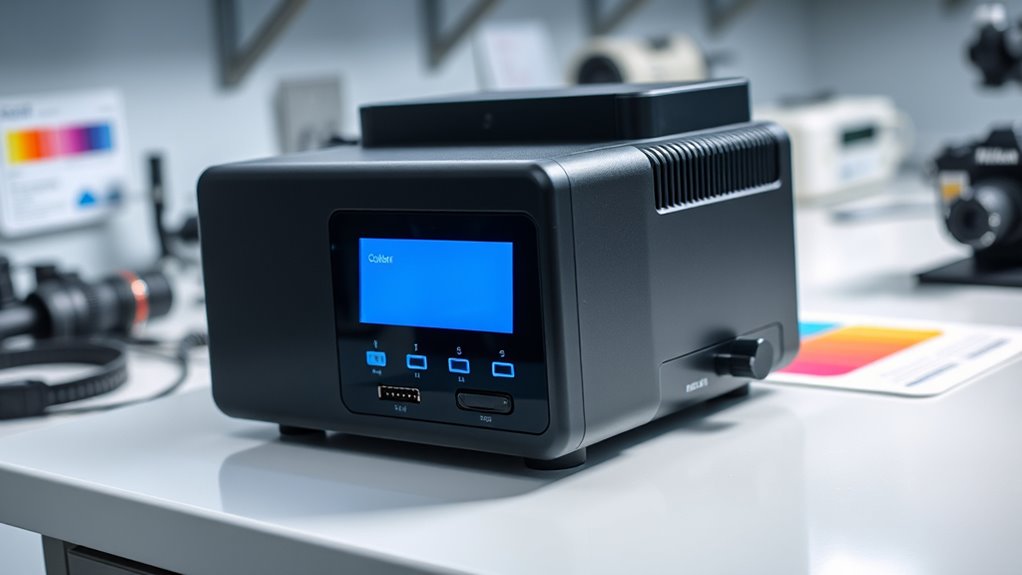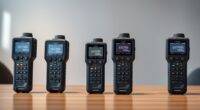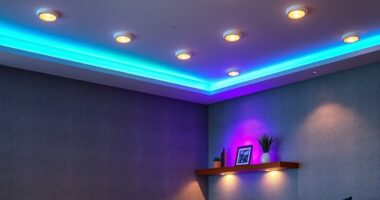If you’re aiming for perfect color accuracy, I recommend exploring the top 15 spectrophotometers designed for photographers. These devices range from handheld models with broad spectral ranges to compact options supporting industry standards like CIE and ASTM. They offer precise color matching, quick measurements, and easy data management. Choosing the right tool depends on factors like portability, measurement range, and connectivity. Keep exploring, and you’ll discover the best options to enhance your photography work.
Key Takeaways
- Offers a variety of portable, handheld, and benchtop models covering spectral ranges from UV to near-infrared for versatile photography color matching.
- Features high accuracy (ΔE*ab ≤0.02) and spectral resolution (2-8nm) to ensure precise color measurement and consistency.
- Equipped with advanced sensors, auto-calibration, and compatibility with industry standards like CIE No.15 for reliable results.
- Supports multiple connectivity options (USB, Bluetooth, Wi-Fi) and color libraries (Pantone, RAL) for seamless data management and color matching.
- Designed with durable, compact build and full-spectrum light sources, ideal for outdoor, studio, and on-site photography color accuracy.
High Performance F97Pro Spectrophotometer
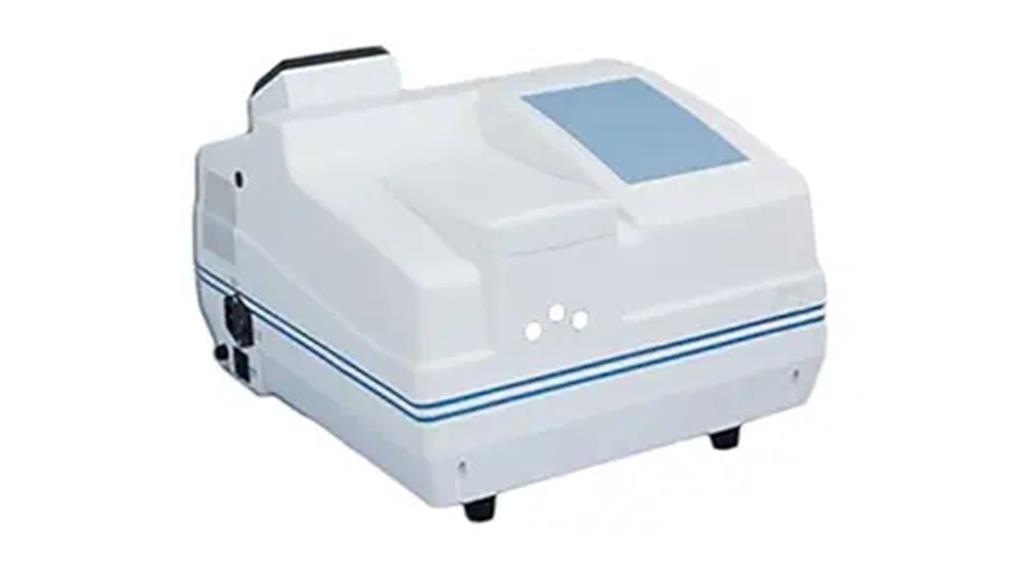
The High Performance F97Pro Spectrophotometer is ideal for photographers and researchers who need precise fluorescence analysis with speed and high sensitivity. I find its wide spectral range from 200 to 900nm perfect for detailed color measurements. The double monochromator design allows rapid scanning at 48,000nm/min, giving quick, reliable results. Its high-efficiency optical system and weak signal detection technology ensure exceptional sensitivity, even for faint signals. The dual-beam ratio monitoring maintains measurement stability, which is essential for accurate color calibration. Overall, this instrument combines speed, accuracy, and versatility, making it a top choice for advanced fluorescence and color analysis.
Best For: Researchers and professionals requiring precise, rapid fluorescence and color analysis with high sensitivity and wide spectral coverage.
Pros:
- Exceptional spectral range from 200 to 900nm for detailed analysis
- Very fast scanning speed of 48,000nm/min for rapid data collection
- High sensitivity and stability due to advanced optical design and dual-beam monitoring
Cons:
- Potentially high cost due to advanced features and technology
- May require specialized training to operate at optimal performance
- Larger size and weight could limit portability for some users
Nix Spectro L Spectrophotometer and Densitometer
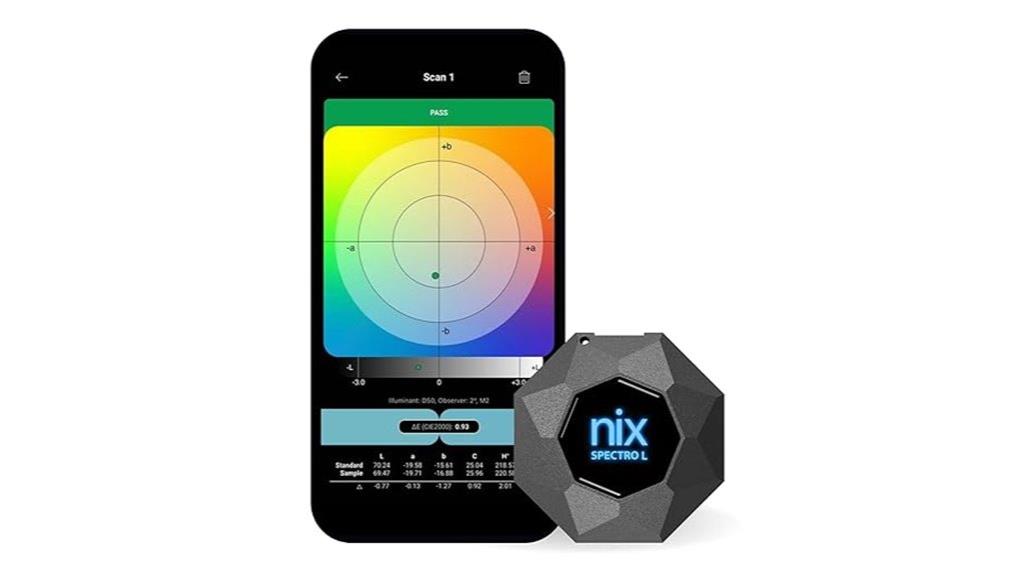
If you’re a photographer or a print professional seeking precise color matching, the Nix Spectro L Spectrophotometer and Densitometer stands out as an ideal tool. It delivers professional-grade color measurement for print, packaging, and graphic arts, helping you save time and reduce waste. With support for CMYK, RGB, HEX, and detailed Delta-E analysis, it offers accurate color detection. Its advanced sensor technology includes 31 channels and modes like M0, M1, and M2 for versatile readings. Plus, with the Nix Toolkit app, you can access extensive color libraries and create custom, cloud-enabled palettes, ensuring consistent, high-quality color control.
Best For: photographers, print professionals, and graphic artists seeking precise, professional-grade color measurement and matching tools for print, packaging, and visual arts.
Pros:
- Supports a wide range of color detection including CMYK, RGB, HEX, and detailed Delta-E analysis for high accuracy.
- Equipped with advanced 31-channel sensor and multiple modes (M0, M1, M2) for versatile and precise measurements.
- Enables access to extensive color libraries and custom cloud-enabled palettes via the Nix Toolkit app, enhancing workflow and consistency.
Cons:
- Premium features and library access may require additional subscription costs.
- May have a learning curve for new users unfamiliar with professional color matching tools.
- Requires USB-C charging, which may not be as widely compatible with older devices.
GOYOJO Portable Spectrophotometer 721
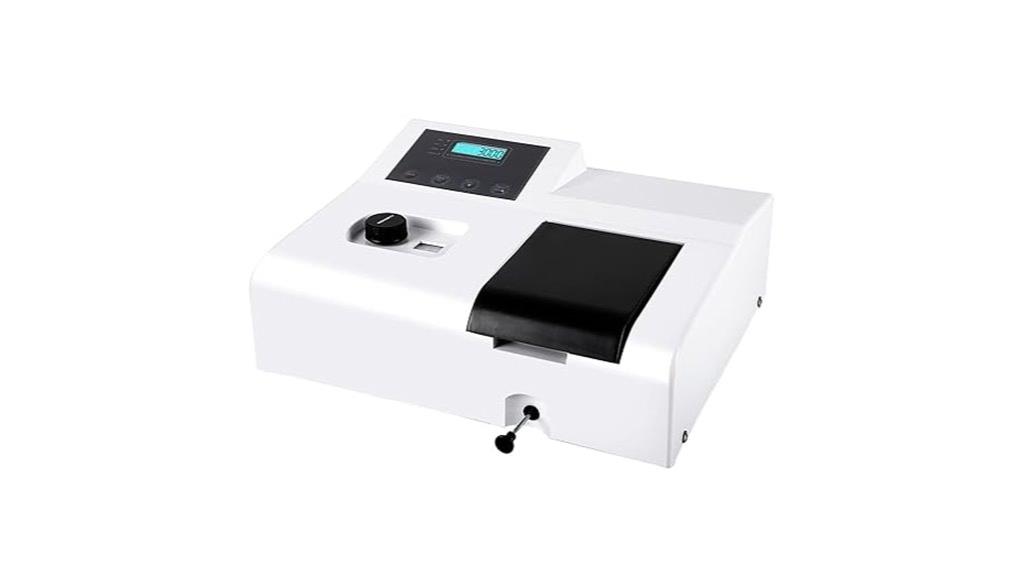
Photographers seeking precise color measurement will appreciate the GOYOJO Portable Spectrophotometer 721, as it delivers high photometric accuracy of ±1%T and excellent stability. Its repeatability of 0.5%T and stability of ±0.004A/h at 500nm guarantees consistent, reliable results. The device features a simple digital display and easy operation, making it accessible even for those unfamiliar with spectrophotometry. With a broad measurement range of 0-200%T and -0.3A to 3A, it suits clinical, food, pharmaceutical, and water quality testing. Built with durable materials, it’s portable and designed for long-term use, backed by responsive customer support.
Best For: photographers and professionals requiring precise color measurement with high accuracy and stability.
Pros:
- High photometric accuracy of ±1%T ensures precise color readings.
- Simple digital display and user-friendly operation facilitate quick setup and use.
- Durable, portable design makes it suitable for various environments and long-term use.
Cons:
- May require calibration to maintain optimal accuracy over time.
- Limited to laboratory and industrial applications; not designed for casual or non-professional use.
- Power source and battery life details are not specified, which could impact portability in certain settings.
Spectro 1 Pro Portable Spectrophotometer for Paint Color Matching
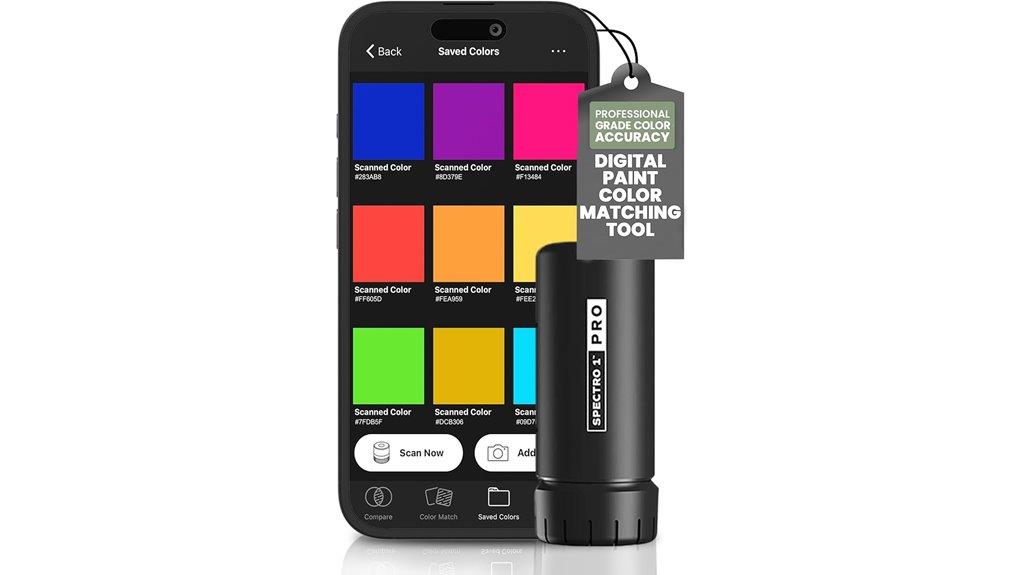
For professionals who need precise color matching on the go, the Spectro 1 Pro Portable Spectrophotometer stands out as an essential tool. It combines a color checker, reader, and scanner to deliver exceptional accuracy, ensuring consistent results regardless of lighting conditions. Ideal for industries like paint, coatings, textiles, and design, it works well on glossy surfaces and various materials. Its extensive color libraries, including Sherwin-Williams, RAL, Benjamin Moore, Pantone, and NCS, offer unmatched flexibility. Compact and wireless, it easily connects to the Spectro by Variable app, allowing quick, reliable color analysis anytime, anywhere—saving time, reducing errors, and boosting client satisfaction.
Best For: professionals in paint, coatings, textiles, and design seeking portable, precise color matching solutions for various materials and surfaces.
Pros:
- Exceptional accuracy with spectral curve data for consistent color matching across lighting conditions
- Extensive compatibility with major color libraries such as Sherwin-Williams, RAL, Benjamin Moore, Pantone, and NCS
- Portable and wireless design allows for on-the-go use and seamless connectivity via iOS and Android apps
Cons:
- May require initial training to maximize the device’s advanced features and spectral data interpretation
- Higher cost compared to basic color matching tools, which might be a consideration for smaller businesses
- Dependence on app connectivity could pose challenges in areas with limited wireless access
Black Portable Spectrophotometer with LCD, USB, Tungsten Lamp, 320-1100nm
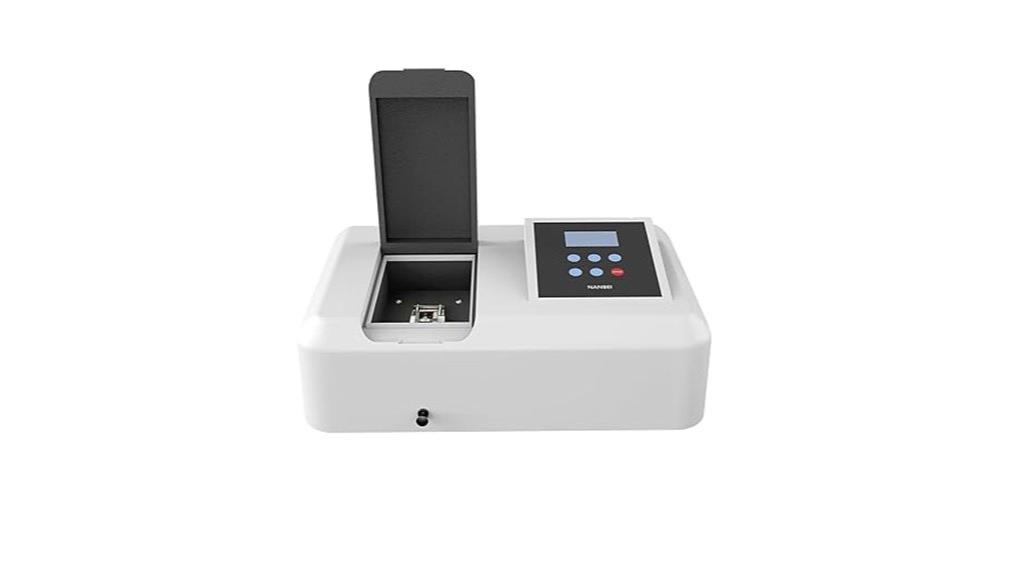
The Black Portable Spectrophotometer with LCD, USB, Tungsten Lamp, 320-1100nm stands out as an ideal choice for professionals who need precise and reliable color measurements in the field or laboratory. Its spectral range covers visible to near-infrared wavelengths, making it versatile for various applications like medical testing, food analysis, and environmental monitoring. The device features a backlit LCD for easy readings, USB connectivity for quick data transfer, and automatic wavelength adjustment with ±1nm accuracy. Compact and portable, it includes four cuvettes for sample testing. Preheating guarantees measurement stability, providing dependable results every time.
Best For: professionals in medical, food, petrochemical, and environmental fields requiring precise, portable spectrophotometry for field and laboratory analysis.
Pros:
- High wavelength accuracy of ±1nm ensures reliable measurements
- Compact, portable design with USB connectivity for convenient data transfer
- Wide spectral range of 320-1100nm suitable for diverse applications
Cons:
- Requires preheating for 30 minutes before use, which may delay initial testing
- Spectral bandwidth of 4nm may limit ultra-high-precision measurements
- Limited to specific cuvette sizes (1x1cm) without additional adapters
EISCO Premium Quantitative Spectroscope
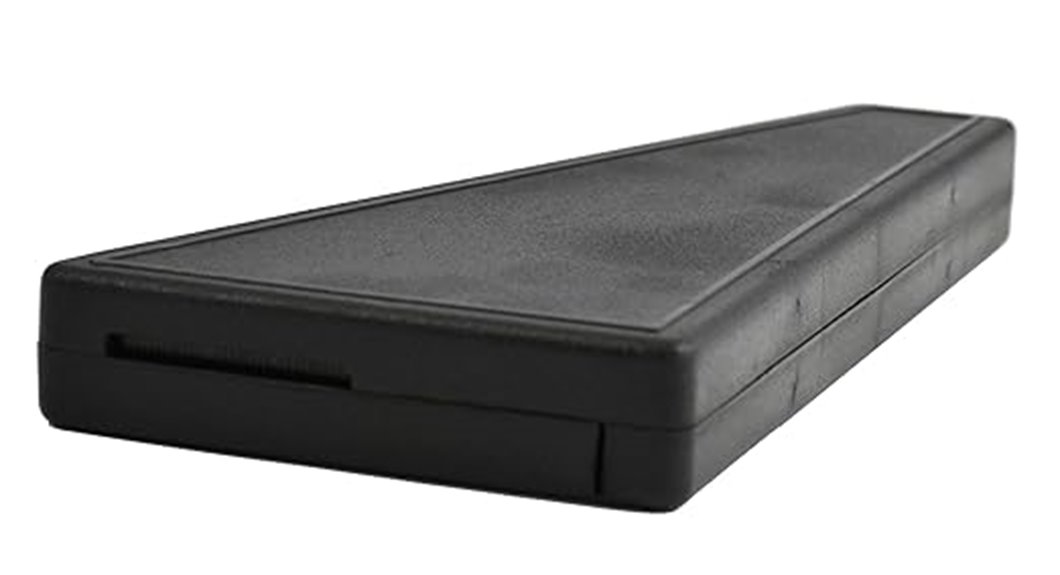
If you need a spectroscope that delivers high-resolution spectral analysis, the EISCO Premium Quantitative Spectroscope is an excellent choice. It’s versatile, suitable for studying light sources, analyzing color spectra, and conducting detailed experiments like flame tests or astronomy observations. Its wide measurement range of 400.0 to 700.0 nm covers the entire visible spectrum, ensuring exhaustive analysis. The innovative design includes a secure diffraction grating holder for clear readings, reducing errors. Equipped with a 500 lines/mm diffraction grating, it provides sharp, high-resolution spectra. With an accuracy of ±5.0 nm, it delivers reliable results for precise scientific and artistic applications.
Best For: educators, students, and researchers seeking precise spectral analysis for experiments in chemistry, physics, and astronomy.
Pros:
- Wide measurement range from 400.0 to 700.0 nm covers the entire visible spectrum for comprehensive analysis
- High-resolution 500 lines/mm diffraction grating provides sharp, detailed spectral readings
- Secure holder design ensures clear, accurate measurements with minimal errors
Cons:
- Measurement accuracy is limited to ±5.0 nm, which may not be sufficient for highly sensitive research
- The device may be fragile if not handled carefully due to its optical components
- Slightly more complex setup compared to basic spectroscopes, requiring proper alignment for optimal results
Nix Spectro 2 Spectrophotometer and Densitometer

The Nix Spectro 2 Spectrophotometer and Densitometer stands out as an ideal choice for print professionals who need precise color measurements on control strips. Its 2mm targeting jig ensures accurate data collection tailored for the print industry, making it easy to measure colors consistently. The device works seamlessly with Nix Print Pro software, offering actionable insights to reduce waste and improve workflow efficiency. Plus, its compatibility with extensive color libraries like Pantone, RAL, and NCS enhances color matching. It’s a cost-effective, portable solution that delivers reliable, professional-grade results without the high price of traditional benchtop instruments.
Best For: print professionals and packaging designers seeking precise, reliable color measurement and quality control on control strips with a portable, cost-effective device.
Pros:
- Accurate color measurements tailored for the print industry with a 2mm targeting jig
- Seamless integration with Nix Print Pro software and access to extensive color libraries like Pantone, RAL, and NCS
- Portable and affordable alternative to traditional benchtop spectrophotometers
Cons:
- Requires the targeting jig to function, limiting standalone use
- Software is sold separately, adding to overall cost
- Limited to print and packaging applications, not suitable for other industries
Digital Lab Spectrophotometer with LCD Display 350-1020nm
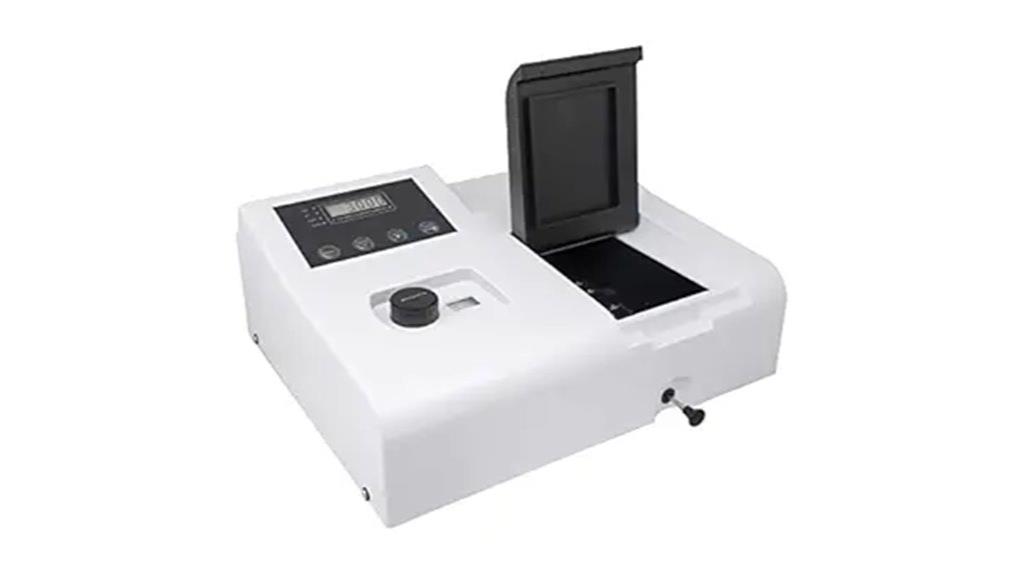
A Digital Lab Spectrophotometer with LCD Display 350-1020nm stands out as an ideal tool for photographers who need precise color measurement and analysis. Its visible spectral range covers 350-1020nm, making it versatile for various applications like quality control and environmental testing. The device features four LCD displays for easy data reading, supporting photometric modes such as T, A, and C. With a silicon photodiode detector, it offers high accuracy, a spectral bandwidth of 6nm, and calibration features for consistent results. The large sample chamber and durable construction ensure reliable performance, making it a valuable instrument for achieving perfect color fidelity.
Best For: professionals in laboratories and quality control settings who require precise color measurement and spectral analysis across a broad visible range.
Pros:
- High accuracy with spectral bandwidth of 6nm and calibration features for consistent results
- Large sample chamber accommodates various sample sizes for versatile testing
- Durable construction and long-lasting light sources ensure reliable, long-term performance
Cons:
- May be more expensive than simpler spectrophotometers, limiting accessibility for small labs
- Requires proper calibration and handling to maintain measurement precision
- Not specifically tailored for photography or color grading applications outside laboratory environments
Portable Spectrocolorimeter Spectrophotometer with USB Data Storage
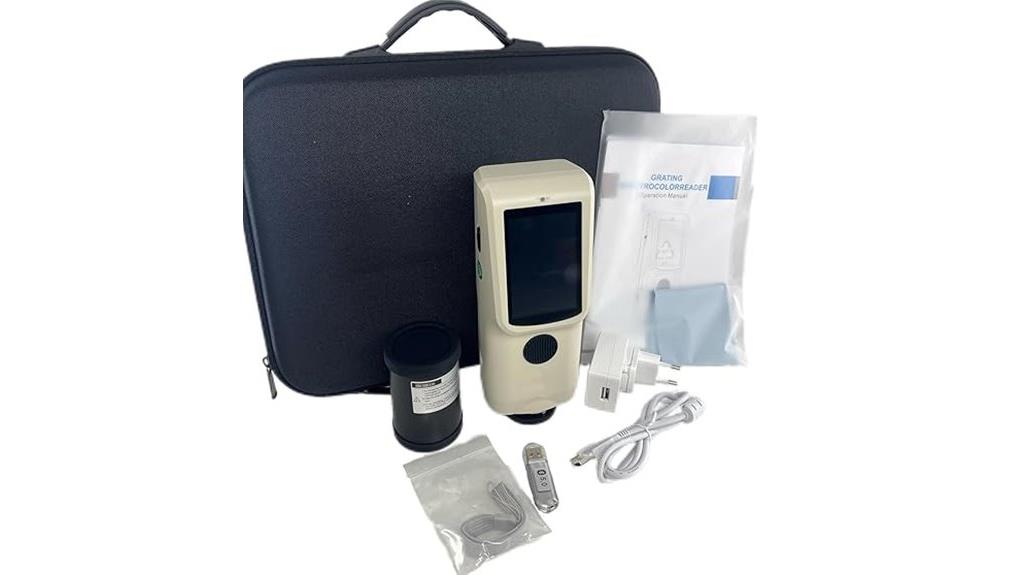
Photographers seeking accurate color matching on the go will find the portable spectrocolorimeter with USB data storage an invaluable tool. It features a full-band balanced LED light source that covers the visible spectrum, ensuring reliable measurements without spectrum gaps. Its silicon photodiode array sensor offers high sensitivity, stability, and fast readings. Using grating spectrophotometric technology, it delivers high-resolution, precise color data. With storage for up to 10,000 samples and a USB interface, managing large datasets is effortless. Its 8mm aperture guarantees accurate targeting, while the professional-grade design keeps the measurement area clean, maintaining color integrity during every session.
Best For: Photographers and visual professionals who need portable, accurate color measurement on location or in the field.
Pros:
- High precision with grating spectrophotometric technology ensures reliable color data.
- Large storage capacity of up to 10,000 samples facilitates extensive data management.
- USB interface allows easy data transfer and seamless integration with other devices.
Cons:
- May be more expensive compared to basic color measurement tools.
- Requires careful handling to maintain measurement accuracy and calibration.
- The device’s size and features might be overkill for casual or infrequent users.
CHNSpec CS-580 Portable Spectrophotometer
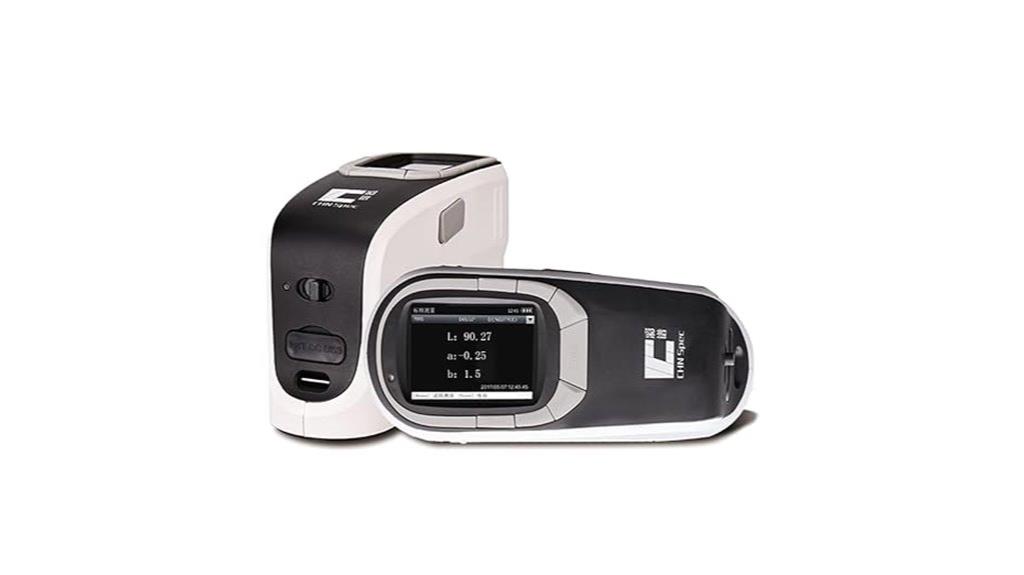
For photographers and professionals demanding top-tier color accuracy in their work, the CHNSpec CS-580 Portable Spectrophotometer offers unmatched precision and ease of use. Its compact, lightweight design makes it highly portable, perfect for on-the-go measurements. The device supports industry standards like CIE No.15 and ASTM E1164, ensuring reliable results across various applications. With features like a built-in camera, auto-calibration, and Bluetooth connectivity, it simplifies color measurement while maintaining high repeatability—ΔE*ab ≤0.03. Its durable build and extensive software make it an ideal choice for photographers seeking consistent, accurate color data in diverse environments.
Best For: professionals in photography, fashion, and design who require precise and consistent color measurement in various environments.
Pros:
- High color measurement accuracy with ΔE*ab ≤0.03 for reliable results
- Compact, lightweight, and portable design ideal for on-the-go use
- Supports industry standards like CIE No.15 and ASTM E1164 for versatile applications
Cons:
- May require training to fully utilize advanced features and calibration processes
- Limited to specific measurement geometries, which might not suit all color assessment needs
- Higher initial investment compared to basic color measurement tools
Spectrophotometer Φ11mm Handheld Spectrophotometer with High Accuracy
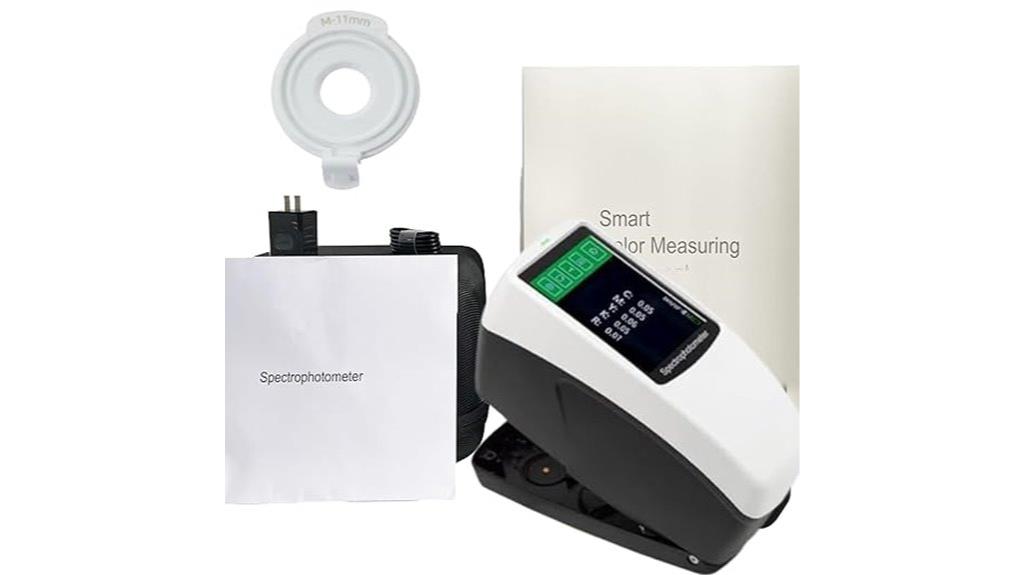
The handheld Φ11mm spectrophotometer stands out with its high-precision nano-spectrophotometer technology, delivering ultra-high repeatability with a ΔE*ab≤0.02. Its compact, horizontal design with a low center of gravity ensures stability during surface measurements. Equipped with a Φ11mm aperture and a physical observation window, it guarantees accurate positioning across various sample sizes. Supporting over 30 chroma indicators and 40 evaluation light sources—including D65 and D50—it provides detailed spectral data. With a measurement time of about one second, it seamlessly integrates with Windows systems via Bluetooth or USB, paired with powerful ColorExpert software for precise color management.
Best For: professionals and industries requiring precise, rapid, and stable color measurement across diverse sample sizes and environments.
Pros:
- High-accuracy nano-spectrophotometer technology with ΔE*ab≤0.02 ensures exceptionally reliable color measurements.
- Compact, handheld design with a low center of gravity provides excellent stability and ease of use during surface assessments.
- Supports extensive measurement parameters and industry-standard light sources, compatible with comprehensive color management software.
Cons:
- Limited aperture size (Φ11mm) may not accommodate very large or irregular sample surfaces.
- Reliance on Bluetooth or USB connection may pose challenges in environments with poor connectivity.
- As a specialized device, it may require user training to fully leverage its advanced features and software integration.
Color Spectrometer Portable Spectrophotometer for Color Analysis in Industries
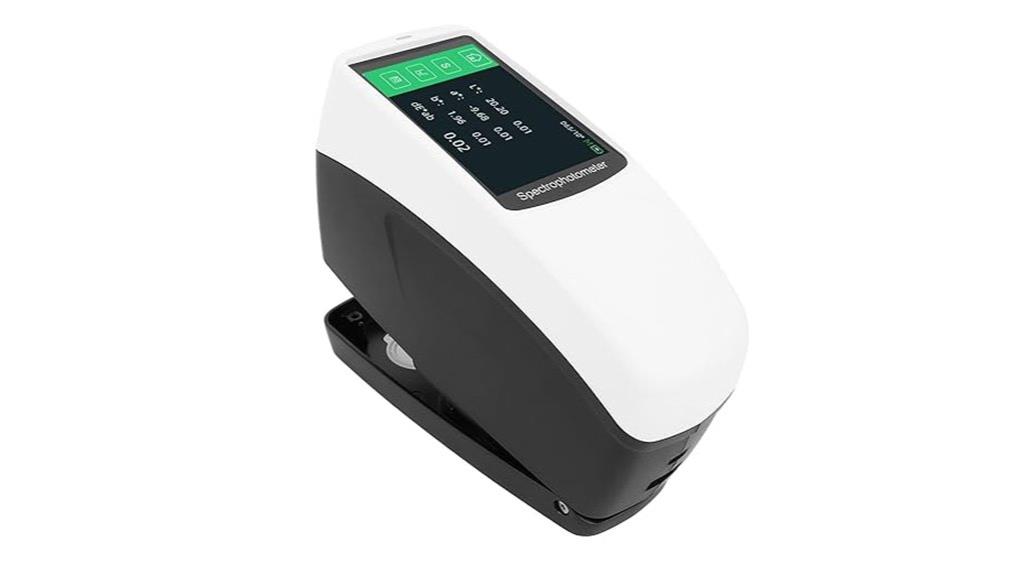
When precise color analysis is essential across various industries, a portable spectrophotometer like the DS62 stands out as an ideal tool. Its durable ABS design features a low center of gravity to prevent tipping during measurements and an integrated stability hole. The device boasts a full-color 3.5-inch display, USB connectivity, and compatibility with Android and iOS apps. With measurement apertures from 3mm to 11mm, it offers versatility for different applications. Powered by a rechargeable battery, it can perform around 8,000 measurements per charge. Its rapid, accurate readings support quality control across textiles, plastics, coatings, and more, ensuring consistent color standards industry-wide.
Best For: industries requiring precise and portable color measurement solutions such as textiles, plastics, coatings, and research laboratories.
Pros:
- Compact and portable design with durable ABS construction for easy field use
- Rapid measurement capability (~1 second) with high reproducibility for efficient quality control
- Supports a wide range of industry standards and over 30 measurement indicators for versatile applications
Cons:
- Limited measurement aperture sizes may not suit all sample types or sizes
- Battery life (~8,000 measurements) might require frequent recharging during intensive use
- Advanced features and multiple light source options could present a learning curve for new users
Spectrophotometer with Aperture Ø8mm and USB Storage
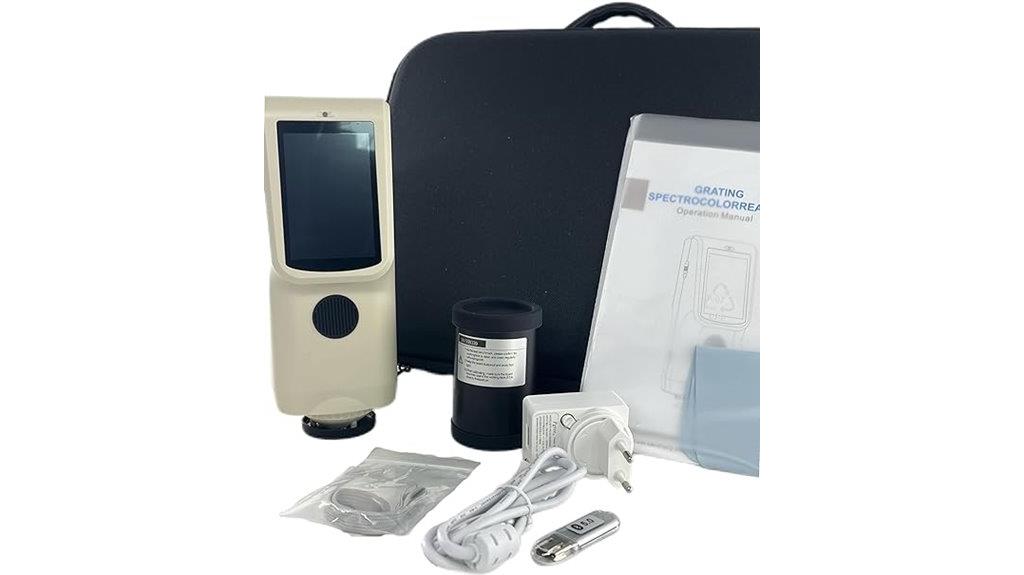
Photographers seeking precise color measurement will find the spectrophotometer with an Ø8mm aperture and USB storage particularly valuable. Its full-band balanced LED light source delivers accurate spectral data quickly, while the silicon photodiode array guarantees high sensitivity and stability, even with low light. Using grating spectrophotometry, it attains higher resolution for more precise color analysis. The device’s aperture size permits consistent measurements, and its USB storage can hold up to 10,000 samples, making data management easy. Designed with durability and user-friendliness in mind, it’s an excellent tool for ensuring color accuracy across various photographic applications.
Best For: Photographers and color professionals seeking precise, reliable color measurement with efficient data management.
Pros:
- High sensitivity and stability due to silicon photodiode array sensor
- Higher resolution from grating spectrophotometric technology for accurate color analysis
- Large USB storage capacity up to 10,000 samples for easy data management
Cons:
- Handheld design may require steady handling for consistent results
- Aperture size of Ø8mm might be limiting for very large or very small sample areas
- Potentially higher cost compared to simpler color measurement tools
Vis Spectrophotometer with LCD Display

A Vis Spectrophotometer with an LCD display is an ideal choice for professionals who need precise, reliable measurements in a compact and user-friendly package. I find the 721 LDC model particularly impressive with its wavelength range of 350-1020nm and ±2nm accuracy. Its large sample chamber handles bigger cuvettes easily, while the durable tungsten lamp guarantees long-term use. The digital LCD makes readings straightforward, and features like automatic zero adjustment simplify operation. With optional RS232 connectivity, I can easily transfer data to printers or computers. It’s a versatile, economical instrument perfect for various fields, from medical to environmental, ensuring accurate color analysis every time.
Best For: professionals in medical, food, petrochemical, and environmental laboratories seeking precise, reliable visible light analysis with user-friendly features.
Pros:
- Wide wavelength range of 350-1020nm for versatile applications
- Large sample chamber accommodates bigger cuvettes for flexibility
- Digital LCD display ensures easy, accurate readings and operation
Cons:
- Requires 110V power supply, limiting portability in some regions
- Optional RS232 interface may add to overall cost
- Spectral bandwidth of 6nm may not be suitable for ultra-high precision needs
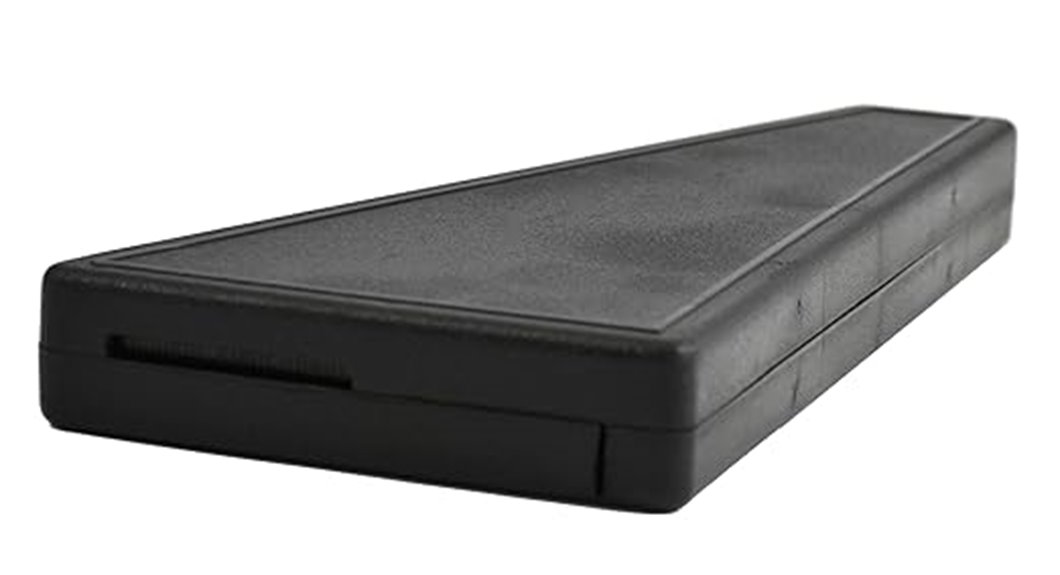
The EISCO Premium Quantitative Spectroscope is an ideal choice for students and hobbyists who want a reliable tool to analyze light sources within the 400-700nm range. Its durable plastic housing and stable diffraction grating guarantee accurate, bright readings, making it suitable for educational and basic spectroscopy tasks. The adjustable slit improves spectral resolution, while the illuminated scale allows easy reading even in low light. With a measurement accuracy of ±5nm, it can identify emission peaks from LEDs, bulbs, and other sources. Although not suited for detailed scientific research, it provides a straightforward, cost-effective way to explore and compare spectra for learning and hobbyist applications.
Best For: students, hobbyists, and educators seeking an affordable, durable spectroscope for basic spectral analysis within the 400-700nm range.
Pros:
- Durable plastic housing with stable diffraction grating ensures bright, reliable readings
- Adjustable slit and illuminated scale improve spectral resolution and ease of use in low light
- Cost-effective and straightforward, ideal for educational and introductory spectroscopy
Cons:
- Limited resolution with broad spectral bands due to slit size, causing wavelength variations of 20-30nm
- Not suitable for detailed scientific research or high-precision spectral analysis
- Scale may require backlighting and careful alignment for accurate readings in dark environments
Factors to Consider When Choosing a Spectrophotometer for Photographers
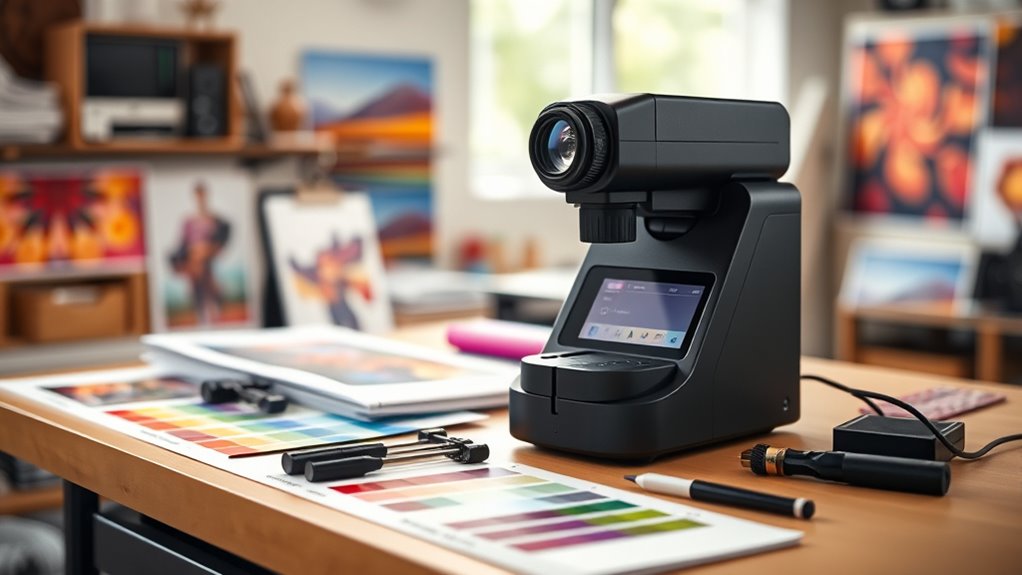
When selecting a spectrophotometer, I consider factors like spectral range and measurement accuracy to guarantee precise color matching. Portability and size matter if I need to use it on location, while compatibility with light sources and data connectivity can streamline my workflow. Understanding these key points helps me choose the right device for my photography needs.
Spectral Range Needs
Have you ever wondered if your spectrophotometer covers all the colors you need for accurate photography? Ensuring it spans the full visible spectrum (about 380-740nm) is essential for analyzing most photographic samples precisely. If you work with specialty materials or artistic effects, consider models that extend into ultraviolet (UV) and near-infrared (NIR) ranges for added flexibility. Matching the device’s spectral range with common color spaces like sRGB or Adobe RGB helps achieve accurate color matching. For exhaustive color calibration and correction, a spectrophotometer that covers the entire visible spectrum is ideal. Broader ranges, including UV and NIR, are particularly useful for specialized tasks like digital print proofing or archival work, providing more detailed and versatile color data.
Measurement Accuracy Levels
Choosing a spectrophotometer with the right measurement accuracy is vital for achieving consistent and true-to-life color results in photography. Higher accuracy levels, like ΔE*ab ≤0.02, allow for more precise color matching and consistency across projects. Devices with spectral bandwidths of 2-4nm deliver finer resolution, capturing detailed color nuances. Wavelength accuracy within ±1nm or better minimizes errors, guaranteeing accurate color reproduction. Repeatability, typically within 0.01 to 0.05, indicates the device’s ability to produce reliable results over multiple measurements. Additionally, calibration stability is essential; automatic calibration features help maintain accuracy over time, especially with frequent use. Prioritizing these accuracy factors ensures your workflow delivers consistent, professional-quality colors every time.
Portability and Size
Portability and size are essential factors for photographers who need to perform accurate color measurements on the go. A lightweight spectrophotometer, ideally under 1.5kg, makes outdoor and on-site assessments much easier. Compact devices, with dimensions less than 20cm, fit comfortably in camera bags or toolkits, allowing quick setup in tight spaces. Small form factors enable fast measurements without sacrificing precision, even in limited environments. Many portable models feature rechargeable batteries, so you can work away from mains power—perfect for fieldwork. Additionally, ergonomic design reduces fatigue during extended use, guaranteeing consistent results without strain. Choosing a device that balances size, weight, and ease of handling helps streamline your workflow and ensures you’re always ready for accurate color calibration wherever your photography takes you.
Light Source Compatibility
Selecting a spectrophotometer that is compatible with various light sources is essential for achieving accurate color measurements across different environments. It’s important to guarantee the device covers the spectral range from 350nm to 780nm, which includes the full visible spectrum for photography. Compatibility with common light sources like tungsten, LED, fluorescent, and natural sunlight allows for precise color evaluations regardless of lighting conditions. Full-band balanced LED light sources offer consistent, flicker-free illumination, enhancing reliability. Additionally, the spectral uniformity and stability of the light source directly impact measurement accuracy, especially when assessing subtle color differences. If you work with diverse photographic materials, confirm that the optical design supports both reflective and transmissive measurements to ensure versatility across your projects.
Data Connectivity Options
To guarantee smooth and efficient workflows, it’s crucial to take into account a spectrophotometer’s data connectivity options, as these determine how easily you can transfer and analyze color measurement data. I recommend choosing models with multiple connectivity options like USB, Bluetooth, and Wi-Fi to maximize flexibility. USB interfaces offer direct, reliable connections to computers, making data export straightforward for detailed analysis. Wireless features such as Bluetooth or Wi-Fi enable remote operation and real-time data sharing with mobile devices or tablets, streamlining your workflow. Compatibility with popular software platforms and apps is essential for seamless integration. Additionally, prioritize devices with secure, high-speed data transfer protocols to minimize errors and ensure data integrity, especially when handling large or frequent uploads.
Ease of Calibration
Ensuring your spectrophotometer is easy to calibrate can save you time and prevent errors during color measurement. I recommend choosing a device with automatic calibration features, so you don’t have to manually adjust it each time. Look for models that offer quick zero and full-scale calibration processes—this makes setup faster and more efficient. Clear calibration instructions or built-in guidance are essential to minimize user errors and guarantee consistent results. Stability over repeated measurements is also vital; a reliable instrument will maintain calibration accuracy over time, saving you from frequent recalibrations. Additionally, consider devices with calibration memory or recall functions, which allow you to effortlessly restore previous calibration settings, guaranteeing ongoing precision during your work.
Industry Standards Compliance
When choosing a spectrophotometer, verifying its conformity with industry standards is a key step to guarantee you get reliable and consistent color measurements. Confirm the device complies with standards like CIE No.15, ASTM E1164, or ISO 7724, which verify measurement accuracy. Check that it supports calibration protocols aligned with international standards, enabling precise color matching and ΔE calculations such as ΔE*00 or ΔE94. Compatibility with recognized color libraries like Pantone, RAL, or NCS is also essential for meeting industry-specific requirements. Additionally, confirm the device follows measurement geometry standards (e.g., D/8, SCI/SCE) for consistent results across lighting conditions. Finally, look for certifications or validation reports that demonstrate compliance with relevant regulations, ensuring the spectrophotometer’s quality and reliability.
Frequently Asked Questions
How Do Spectrophotometers Improve Color Consistency in Photography Workflows?
Spectrophotometers improve color consistency in my photography workflow by precisely measuring the color values of my prints and displays. I use them to calibrate my monitors and printers, ensuring colors match across devices. This accuracy helps me maintain a consistent look in my work, preventing color shifts. By regularly checking and adjusting with a spectrophotometer, I can confidently produce images with perfect, reliable color accuracy every time.
What Maintenance Is Required to Keep a Spectrophotometer Accurate Over Time?
To keep my spectrophotometer accurate over time, I regularly calibrate it with certified calibration standards and follow the manufacturer’s recommended maintenance schedule. I also keep it clean by gently wiping the sensor with a lint-free cloth and avoid exposing it to extreme temperatures or dust. Periodic software updates ensure peak performance, and I store it in a protective case when not in use to prevent damage.
Can Portable Spectrophotometers Be Used for Large-Format Printing Calibration?
Yes, portable spectrophotometers can be used for large-format printing calibration, but with some limitations. I recommend choosing a model with high accuracy and a wide measurement range to handle large prints effectively. Keep in mind that environmental factors like ambient light and temperature can influence readings. Regular calibration and proper handling ensure consistent results, making portable devices a practical option for on-the-go calibration of large-format prints.
How Do Different Light Sources Affect Spectrophotometer Color Measurements?
Different light sources markedly impact spectrophotometer color measurements because each type emits light with unique spectral power distributions. When I measure colors under incandescent, fluorescent, or daylight, I see variations in readings due to these differences. To guarantee consistent results, I always calibrate my device with a standard light source and use standardized lighting conditions. This approach helps me achieve accurate, repeatable color measurements regardless of the environment.
Are There Specific Spectrophotometers Recommended for Underwater or Specialty Lighting Conditions?
Think of underwater or specialty lighting like a hidden treasure chest—challenging but rewarding. I recommend spectrophotometers like the X-Rite eXact or Konica Minolta’s CS-2000A, designed for tricky environments. They’re like trusty underwater explorers, calibrated to handle unique light conditions and maintain color fidelity. These tools let you capture vivid, true-to-life colors even in the most complex lighting, ensuring your images stay sharp, accurate, and breathtaking.
Conclusion
Whether you’re seeking precision, portability, or versatile features, these spectrophotometers have you covered. They help you measure, match, and perfect colors with confidence. They guarantee accuracy, enhance creativity, and elevate your work to new levels. By choosing the right tool, you can capture true colors, achieve consistent results, and bring your artistic vision to life. In the end, it’s about matching, measuring, and mastering every hue you encounter.
